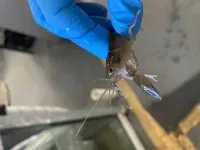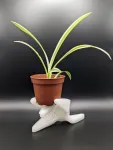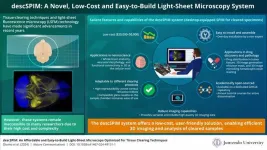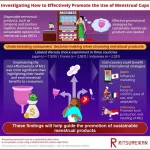(Press-News.org) COLUMBUS, Ohio – A new study in mice hints at the promise of an eventual alternative treatment option for the “wet” version of age-related macular degeneration (AMD).
Researchers determined in mice that an enzyme related to cell growth and division is a culprit in the blood vessel invasion in the back of the eye that causes blurred central vision in wet AMD. Targeting the enzyme, called telomerase, with an experimental drug suppressed abnormal vascular growth in the animals’ retina.
The only current treatment for wet AMD is injection into the eye of a medication that blocks the activity of a growth factor protein, called VEGF, which is also known to prompt formation of abnormal blood vessel growth in this condition.
“Anti-VEGF treatment has shortcomings – after two years, about half of people stop responding. And patients can develop scarring under the retina,” said senior study author Nagaraj Kerur, associate professor of ophthalmology and visual sciences in The Ohio State University College of Medicine.
“There is a need for better understanding of the mechanisms behind this problem, which, to me, means newer targets need to be tested.”
The study was published recently in the journal Biochimica et Biophysica Acta – Molecular Basis of Disease.
Dry age-related macular degeneration constitutes about 80% of all AMD cases, and occurs when the macula, a part of the retina, gets thinner, leading to buildup of proteins and cell death, which blur a person’s central vision.
Wet AMD, also known as neovascular AMD, is caused by the growth of new blood vessels that invade the retina, a space normally free of vascular activity.
“You don’t want to have blood vessels there,” said Kerur, who also has a faculty appointment in microbial infection and immunity at Ohio State. “And the blood vessels that invade are often not healthy – they leak their contents and cause inflammation.”
Previous cancer research has linked high activity of telomerase to rapid production and migration of cells lining blood vessels that enables tumor growth, and has also shown the enzyme can stimulate production of VEGF. Based on those findings, Kerur and colleagues sought in this study to see if telomerase could have a similar damaging effect in the eye.
A series of experiments first confirmed telomerase has a role in abnormal blood vessel formation in a mouse model of wet AMD. Researchers found that, compared to control mice, expression and activity of one of two genes carrying instructions for making telomerase were higher in the eyes of mice in which rapid growth of new blood vessels was induced with a laser.
In addition, the abnormal blood vessel response to laser injury was significantly lower in mice lacking both telomerase genes, “providing genetically clear evidence that telomerase plays a critical role in development of the disease,” Kerur said.
The team then tested the effects of an experimental compound that inhibits telomerase activity. They confirmed that the drug lowered telomerase activity in healthy mice, and found that injecting it into the eyes of mice with symptoms mimicking wet AMD significantly reduced the abnormal blood vessel invasion.
Telomerase’s job is to rebuild telomeres, which function as protective caps at the end of chromosomes. Telomeres are known to shorten in many types of cells as a consequence of aging, but Kerur said the study suggested localized blocking of telomerase in the eye had no bearing on the enzyme’s telomere-building function.
The experimental treatment’s effectiveness at curbing abnormal blood vessel growth in mice was similar to the current anti-VEGF treatment, Kerur said. But the researchers made an intriguing finding when testing both drugs at lower doses: Individually, a lower dose did not have much of a therapeutic effect, but a combination of both drugs at lower doses gave the best results of all.
“Possibly, one goal would be using a combination therapy rather than one alone,” Kerur said. “But telomerase inhibition by itself can also be pursued independently, and that is the plan.”
This work was supported by National Institutes of Health grants, the Ohio Lions Eye Research Foundation and a Research to Prevent Blindness grant.
Co-authors include Aman Kumar, Vinodhini Jayananthan, Asmaa Zidan, Tyler Heisler-Taylor and Shigeo Tamiya of Ohio State, and Yosuke Nagasaka and Jayakrishna Ambati of the University of Virginia.
#
Contact: Nagaraj Kerur, Nagaraj.kerur@osumc.edu
Written by Emily Caldwell, Caldwell.151@osu.edu; 614-292-8152
END
While the impact of wildfires on terrestrial life has been well studied, only recently has research started to examine the effects of wildfire ash on aquatic organisms. New research reveals that wildfire ash can have lethal consequences on Australian water ecosystems.
Wildfires are becoming more prevalent due to the warming and drying effects of climate change, with Australia becoming especially vulnerable to dangerous bushfires. “Therefore, many Australian species may be threatened by fires,” says Miss Jenelle McCuaig, a Masters student at the University ...
Researchers have recently developed a flexible-yet-sturdy morphing structure inspired by the starfish skeleton that exhibits 4D morphing features with promising applications for robotics, aviation, and medical devices.
“Starfish possess the remarkable ability to effortlessly hold themselves in any body posture by changing the stiffness of their endoskeleton,” says Raman, a PhD student in the Biological Structures and Biomimetics workgroup at Hochschule Bremen - City University of Applied Sciences Bremen, Germany.
Ossicles are calcite microstructures inside starfish bodies that are connected in a ...
Chicago (July 2, 2024) — A new study found that school-aged children who consumed more isoflavones from soy foods exhibited better thinking abilities and attention. These findings pave the way for future research aimed at unraveling how soy foods can positively impact children's cognitive abilities.
Isoflavones are naturally occurring compounds found in various plants, particularly soybeans and soy products. Although previous research in adults has suggested that soy isoflavones can improve memory, the ...
About The Study: The Massachusetts statewide standing order policy was associated with a 32% increase in emergency contraceptive fills at pharmacies versus comparison states. After the policy, fills for prescription-only ulipristal more than doubled and accounted for the observed increases in fills for emergency contraceptives.
Corresponding Author: To contact the corresponding author, Dima M. Qato, Pharm.D., M.P.H., Ph.D., email qato@usc.edu.
To access the embargoed study: Visit our For The Media website at this link https://media.jamanetwork.com/
(doi:10.1001/jama.2024.11715)
Editor’s ...
Washington, D.C.—Researchers have detected anaerobic and aerobic bacteria in commercial tattoo and permanent makeup inks. The findings, reported in Applied and Environmental Microbiology, a journal of the American Society for Microbiology, demonstrate that the inks could be a source of human infections. The new study is particularly notable as it is the first to investigate the presence of anaerobic bacteria in commercial tattoo inks.
“Our findings reveal that unopened and sealed tattoo inks can harbor anaerobic bacteria, known to thrive in low-oxygen environments like ...
Waltham — July 2, 2024 — American Indian/Alaska Native (AI/AN) women with breast cancer have consistently lower rates of breast reconstruction after mastectomy compared to non-Hispanic White women, reports a paper in the July issue of Plastic and Reconstructive Surgery®, the official medical journal of the American Society of Plastic Surgeons (ASPS). The journal is published in the Lippincott portfolio by Wolters Kluwer.
"Despite an upward trend in reconstruction, AI/AN women continue to be less likely to undergo breast reconstruction," comments Jane Hui, MD, MS, ...
A modeling study suggests that influential neighbors can be as effective as despotic leaders at promoting social cooperation. Prosocial behaviors can be difficult to sustain in large societies over the long term, as people give into the temptation to defect to strategies that prioritize the wellbeing of themselves and their immediate family. Stefani Crabtree and colleagues constructed a general theoretical framework to explore how cooperation could arise and be maintained in a large society. The authors explore three possible ...
Mill Valley, CA – June 18, 2024 SRF has established a dedicated account to support research regarding SYNGAP1 missense variants. This account is being launched with a $10,000 donation from Dennis and Janet Nordmoe. This is a cause close to their hearts, as their granddaughter Olivia was diagnosed with SYNGAP1-Related Disorder (SRD) caused by a missense variant earlier this year.
Missense Research: Neglected to Date
“Most diagnosed SYNGAP1-Related Disorder (SRD) patients have protein truncating variants (PTV) as opposed to missense variants. Virtually all PTVs are assumed to have the ...
Three-dimensional (3D) imaging of organs and tissues is vital as it can provide important structural information at the cellular level. 3D imaging enables the accurate visualization of tissues and also helps in the identification of pathological conditions. However, achieving successful 3D imaging necessitates specific prerequisites, including the preparation of 'cleared' tissue samples—biological specimens rendered transparent by removing light-scattering components like lipids to ...
In recent decades, single-use plastics have pervaded modern societies, causing a significant surge in plastic pollution that exacts a heavy toll on our environment. Addressing this issue requires prioritizing sustainable alternatives to single-use plastics wherever feasible.
Disposable menstrual products are a notable contributor to plastic waste, with billions of sanitary napkins and tampons being discarded every year. Despite the availability of sustainable options like menstrual cups (MCs), consumer preference for single-use products ...




